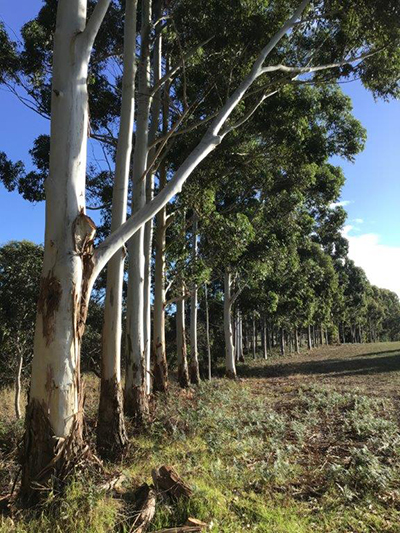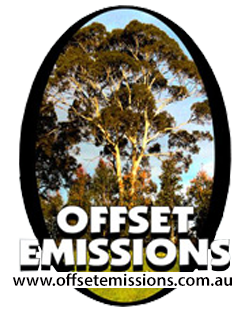CARBON CREDITS
You can help save the Planet NOW!
Purchase Carbon Credits at the current price per tonne. We have the trees that have stored carbon.
our tree varieties
At Loch Dean we have planted the following native trees as they are the largest of the gum varieties and therefore absorb maximum CO2.
SA Blue Gum
(Eucalyptus Leucoxylon)
This local indigenous tree is tall, with a dense and broad spread. It grows very well on the plains of Adelaide and is part of the character of the South Australian landscape. The SA Blue Gum grows straight and very rapidly in its first five to ten years, then slowly develops its broad canopy over subsequent decades. It produces a pale yellow or white flower in the summer and with the River Red Gum, is one of South Australia’s most well known trees.

Spotted Gum
(Eucalyptus Maculata)
Although these trees occur naturally in South-East Queensland and coastal NSW, they also do very well on the Fleurieu Peninsula, South Australia. The bark is smooth and when shed in irregular areas small dimple-like depressions are left which change colour from cream to blue-grey, pink or red resulting in an attractive mottled effect. The tree produces white flowers and usually grows with a tall straight bole and dense crown of glossy green leaves. It is a tree valued for its hard, strong tough timber, and is favored for tool handles.
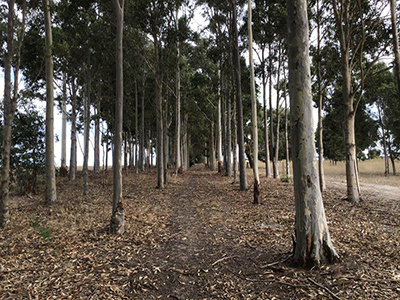
Sugar Gum
(Eucalyptus Cladocalyx)
These trees are native to the Eyre Peninsula, Kangaroo Island and the Flinders Ranges in South Australia and do very well on the Fleurieu Peninsula, South Australia due to the higher rainfall. The bark is a smooth, tan colour and the leaves are dark green and glossy. The leaves are concentrated at the ends of the branches giving the tree an open appearance. The Sugar Gum is widely planted on farms in southern Australia for shelter belts and the wood used for posts and fuel. The tree has also been milled for timber for general construction, poles, and railway sleepers. Has some value in honey production.
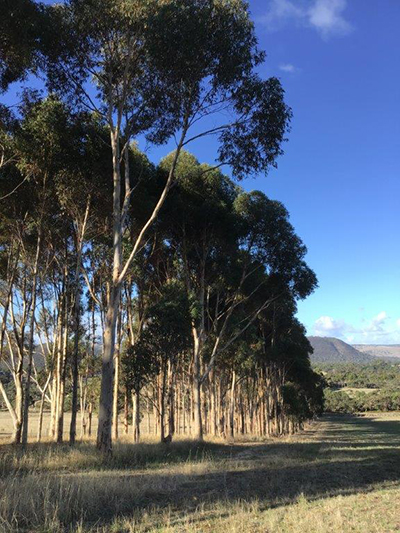
Tasmanian Blue Gum
(Eucalyptus Globulus Globulus)
These trees are native to South-East Tasmania, with occurrences on islands in Bass Strait and on Wilson’s Promontory and the Ottway Ranges in Victoria and do very well on the Fleurieu Peninsula, South Australia. The white to creamy-grey bark is smooth apart from the base, which has persistent slabs, shedding in large strips. The Tasmanian Blue Gum is exceptionally fast growing and hence is grown in large numbers for wood chips. Plantations can be harvested after 7 – 8 years in ideal situations. The flowers appear in spring.
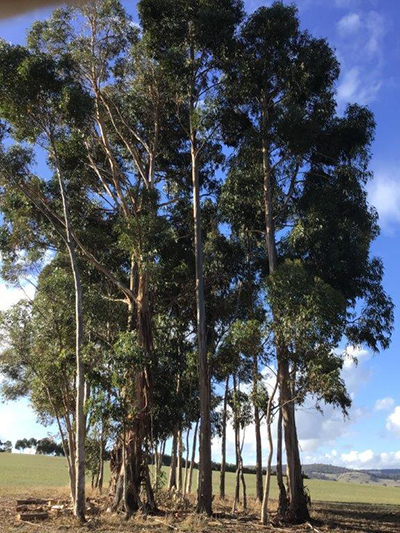
Flooded Gum
(Eucalyptus Grandis)
The Flooded Gum occurs most predominantly on the north coast of NSW, in South-East Queensland in the Atherton area and does well on the Fleurieu Peninsula, South Australia. With smooth powdery white bark, a short stocking of persistent bark and a semi-dense crown of glossy green leaves, the Flooded Gum is similar in appearance to the Sydney Blue Gum. The Flooded Gum is a magnificent fast growing timber tree, with growth rates of up to 7.5m in the first year recorded in plantation situations and annual growth rates of 3m in natural situations. It is a widely useful tree with white flowers occurring from June to August.

Swamp Yate
(Eucalyptus Occidentalis)
The Swamp Yate is generally found in low-lying areas of the southern wheat-belt and south coastal areas of Western Australia. They have rough, grey bark on the trunk and lower parts of the branches giving way to smooth silver-grey or yellow-grey on the upper sections. The Swamp Yate is capable of growing to nearly 6m in 3 years, reaching a mature height of 15 to 25m. They are particularly suitable for growing in heavy, poorly drained situations, are salt tolerant and have pale yellow to cream flowers occurring from March to May.
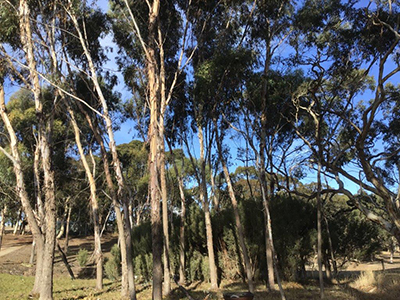
Sydney Blue Gum
(Eucalyptus Saligna)
The Sydney Blue Gum occurs from the Blackdown Tableland in Queensland to Batemans Bay in South-East NSW and grows well on the Fleurieu Peninsula, South Australia due to similar rainfall. With smooth grey bark, a short stocking of persistent bark at the base of the tree and white flowers, the Sydney Blue Gum is similar in appearance to the Flooded Gum. An important fast growing timber tree, in coastal NSW, the Sydney Blue Gum is used for general construction, flooring, cladding, paneling and flowers from January to March.
